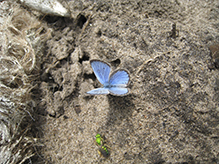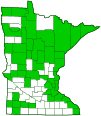Silvery blue
(Glaucopsyche lygdamus)
Conservation • Description • Habitat • Ecology • Distribution • Taxonomy
|
|
||||||||||||||
Description |
Silvery blue is a common, exotic, early season, medium-sized, typical blue butterfly. It occurs throughout the United States and Canada. In the United States it is most common in New England, south along the Appalachian Mountains, and west of the Great Plains. It is mostly absent from the southeast and south-central regions. It is common in Minnesota. Adults are found from late April to mid-June in a variety of habitats, including prairies, meadows, brushy fields, bogs, woodland openings, sand dunes, and roadsides. They can often be found at damp soil or sand. The caterpillars feed on the flowers, seed pods, and leaves of plants in the Legumes (Fabaceae) family, including alfalfa, bird’s-foot trefoil, crown vetch, locoweeds, lupines, milkvetches, sweet clovers, vetches, and wild peas. There are currently 20 living (extant) subspecies and one extinct subspecies of silvery blue. All of the extant subspecies occur in North America. Only one species, Couper’s silvery blue, also called northern silvery blue, occurs in Minnesota. Couper’s silvery blue is native to Canada. It was first found in Maine in 1967, and later in New York in 1984. It was first observed in Minnesota in 2008 in Crow Wing County, then not again until 2011 in Rice County. Its range has been rapidly expanding southward thanks to the introduced cow vetch and crown vetch planted along freeway and highway corridors to control erosion. Adults have a ⅞″ to 1¼″ (22 to 32 mm) wingspan. The wings of the male are iridescent silvery blue above with narrow but distinct black borders. On the female, the wings are darker, duller, and grayish blue, and they have wider but less distinct black borders. On both sexes, the fringe is white. The underside is gray to brown. The forewings and hindwings have a single row of round black spots rimmed with white. |
Size |
Wingspan: ⅞″ to 1¼″ (22 to 32 mm) |
Similar Species |
Eastern tailed-blue (Cupido comyntas) hindwing has a hair-like tail. The forewing has orange caps on 2 or 3 marginal eye spots near the tail. Spring azure (Celastrina ladon) wing underside is lighter. It has many dark spots that form a wide band, not a single row. There is a row of dark chevrons above dark spots in the terminal area. |
Habitat |
A variety of habitats, including prairies, meadows, brushy fields, bogs, woodland openings, sand dunes, and roadsides |
Ecology |
Season |
One generation per year: Late April to mid-June |
Behavior |
|
Life Cycle |
Eggs are laid singly on flower buds and young leaves of host plants. Males emerge in May about one week before females. Pupae overwinter. |
Larva Hosts |
Plants in the Pea (Fabaceae) family, including alfalfa, bird’s-foot trefoil, crown vetch, locoweeds, lupines, milkvetches, sweet clovers, vetches, and wild peas |
Adult Food |
Flower nectar |
Distribution |
||
|
21, 24, 27, 29, 30, 75, 82, 83. Biodiversity occurrence data published by: Minnesota Biodiversity Atlas (accessed through the Minnesota Biodiversity Atlas Portal, bellatlas.umn.edu, 5/19/2024). |
|
| 5/19/2024 | ||
Occurrence |
||
Common |
||
Taxonomy |
|
Order |
|
Superfamily |
Papilionoidea (Butterflies) |
Family |
Lycaenidae (gossamer-winged butterflies) |
Subfamily |
Polyommatinae (blues) |
Tribe |
Polyommatini (typical blues) |
Subtribe |
Scolitantidina |
Genus |
Glaucopsyche |
Subgenus |
Glaucopsyche |
Subordinate Taxa |
|
Afra silvery blue (Glaucopsyche lygdamus afra) Appalachian silvery blue (Glaucopsyche lygdamus nittanyensis) Arizona silvery blue (Glaucopsyche lygdamus arizonensis) Behr’s silvery blue (Glaucopsyche lygdamus incognitus) Columbia blue (Glaucopsyche lygdamus columbia) Couper’s silvery blue (Glaucopsyche lygdamus couperi) false Xerxes blue (Glaucopsyche lygdamus pseudoxerces) Georgian silvery blue (Glaucopsyche lygdamus lygdamus) Jack’s blue (Glaucopsyche lygdamus jacki) Mildred’s silvery blue (Glaucopsyche lygdamus mildredae) mini-spotted silvery blue (Glaucopsyche lygdamus minipunctum) Mohave silvery blue (Glaucopsyche lygdamus deserticola) oro blue (Glaucopsyche lygdamus oro) Palo Verdes silvery blue (Glaucopsyche lygdamus palosverdesensis) Raton Mesa silvery blue (Glaucopsyche lygdamus erico) Sacramento Mountains silvery blue (Glaucopsyche lygdamus ruidoso) sand dune silvery blue (Glaucopsyche lygdamus sabulosa) silvery blue (Glaucopsyche lygdamus maritima) silvery blue (Glaucopsyche lygdamus orcus) southern silvery blue (Glaucopsyche lygdamus australis) Xerxes blue (Glaucopsyche lygdamus xerces) [extinct] |
|
Synonyms |
|
Polyommatus lygdamus |
|
Common Names |
|
silvery blue |
|
Visitor Photos |
||
Share your photo of this insect. |
||
This button not working for you? |
||
Luciearl |
||
 |
 |
|
About 1/2". Took several pics but only one turned out. It happened to be right when it opened its wings. Exterior of wings was a silver blue. 4-5 tiny dots. |
||
Crystal Boyd |
 |
MinnesotaSeasons.com Photos |
||
|
||
|
||

Slideshows |
Silvery Blue |
Silvery Blue (Glaucopsyche lygdamus) |

Visitor Videos |
||
Share your video of this insect. |
||
This button not working for you? |
||
|
Other Videos |
||
Mountain Moment: Silvery Blue Butterfly |
About
Sep 24, 2013 The Silvery Blue Butterfly (Glaucopsyche lygdamus) featured in this Mountain Moment is a common butterfly seen throughout the park. All the butterflies in this video are male, as marked by their distinctive iridescent blue coloring, while female butterflies tend to be brown fading to blue near the base of the wing. Silvery Blues feed on lupine wildflowers. Males are often spotted near host plants patrolling for females. |

Visitor Sightings |
||
Report a sighting of this insect. |
||
This button not working for you? |
||
Luciearl |
Location: Fairview Twp. |
 |
| Luciearl 5/18/2024 |
Location: Cass County About 1/2". Took several pics but only one turned out. It happened to be right when it opened its wings. Exterior of wings was a silver blue. 4-5 tiny dots. |
 |
| Crystal Boyd 6/10 and 6/11/2013 |
Location: Uncas Dunes SNA |
 |
MinnesotaSeasons.com Sightings |
||
|

Created: 10/28/2023 Last Updated: © MinnesotaSeasons.com. All rights reserved. |
